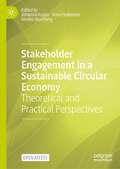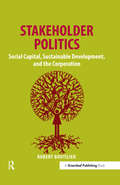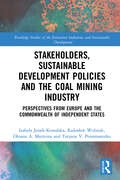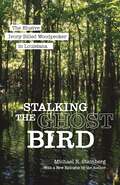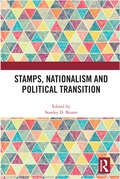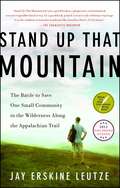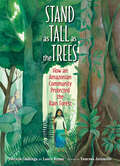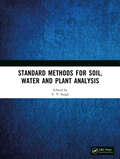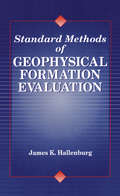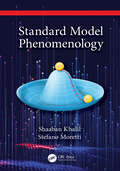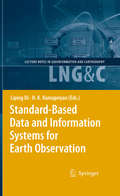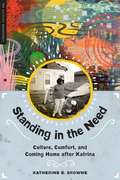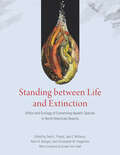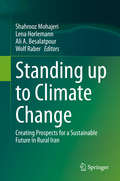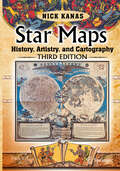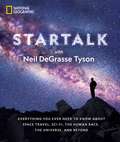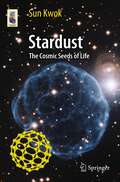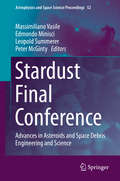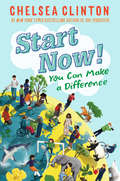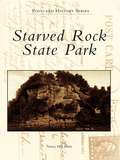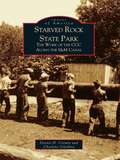- Table View
- List View
Stakeholder Engagement in a Sustainable Circular Economy: Theoretical and Practical Perspectives
by Johanna Kujala Anna Heikkinen Annika BlombergThe purpose of this open access edited collection is to discuss the role and importance of stakeholder engagement in a sustainable circular economy from multiple theoretical and practical perspectives. Developing and maintaining a circular economy is an essential step to a more environmentally friendly and socially inclusive society. In addition to redesigning products and business models to minimise waste and increase the reuse of materials, a transition towards a sustainable circular economy requires collaboration and co-operation between various stakeholders from all parts of society. An international team of contributors explore how stakeholder engagement can foster and support sustainable change, assessing current literature and laying out guidance for future study. The collection is of interest to academics and students of sustainability management and sustainable business models, stakeholder theory and practice, and the circular economy.
Stakeholder Politics: Social Capital, Sustainable Development, and the Corporation
by Robert BoutilierThe war is over. The largest corporations in the world are now committed to sustainability. But, behind the public relations gloss, corporate executives and managers are perplexed. The majority of them have a genuine desire to work in an ethical and sustainable manner. Yet, when they engage with their stakeholders for that purpose, they unexpectedly encounter a world of hardball politics full of hostile activists, self-interested elites and unpredictable attacks. Unfortunately, corporate management is too often unskilled in this rough-and-tumble world. While managers rely on facts and rational analysis, their self-appointed critics have mastered the arts of political discourse, issue framing and media manipulation. At the same time, as corporations extend their global reach, their third-world stakeholder communities are beset with a variety of poverty-maintaining and sustainability-thwarting conditions. In many parts of the world, communities suffer from entrenched divisions, exclusion from power, unpredictable violence and economic dependency. In order to both reduce reputational risk and to contribute to sustainable development, companies need the equivalent of roadmaps of the socio-political terrain in their stakeholder networks.This book moves on to next challenge of giving companies what they need now: namely, "how to" guides addressing the twin problems of firstly maintaining political legitimacy (talking the talk), and, secondly, promoting sustainable development (walking the walk). They need to learn how to both play stakeholder politics and collaborate with stakeholders towards sustainability goals. Most companies have already encountered or anticipated the barriers that this book addresses, and managers will recognize the dilemmas described.Stakeholder Politics is the first book to offer a method for classifying and dealing with these socio-political problems.The book presents a typology of stakeholder networks that will help managers and community leaders identify and improve the social capital patterns in their own networks. Once they know what patterns they have, they can move their networks towards those that foster sustainable community development. The author describes vivid cases in which managers and community stakeholders have already used the approach successfully. At the same time, managers get handy tools for predicting and avoiding community-level socio-political risk around stakeholder issues: most notably, the Stakeholder 360 which has been successfully used in Canada and Australia with large groups of managers learning about stakeholder engagement.The book has been written for an audience of both managers and academics. Those working in developing countries with difficult stakeholder issues will find it indispensable.
Stakeholders, Sustainable Development Policies and the Coal Mining Industry: Perspectives from Europe and the Commonwealth of Independent States (Routledge Studies of the Extractive Industries and Sustainable Development)
by Izabela Jonek-Kowalska Radosław Wolniak Oksana A. Marinina Tatyana V. PonomarenkoThis book identifies the impact of internal and external stakeholders on the implementation of sustainable development policies in the coal mining sector in Europe and the Commonwealth of Independent States. The book assesses what activities and conditions need to be improved so that sustainable development policies can be more effectively and efficiently implemented. With a specific focus on the hard coal and lignite mining sectors, it examines a broad range of case studies from Eastern European countries and the Commonwealth of Independent States, including Russia, Ukraine, Poland, Kazakhstan, Germany, Spain, France and the United Kingdom, among many more. Beginning with an introduction to sustainable development and stakeholder theory, Part II then examines internal stakeholders, including owners, managers, employees and trade unions. Part III examines external stakeholders, touching upon those directly related to the mining industry, such as customers and mining enterprises, and those not directly associated such as local and regional communities and environmental organisations. The book concludes by proposing a model approach to the management of stakeholders involved in mining enterprises, focusing on improving the process of implementing sustainable development in the mining sector and strengthening the effects of this process. This book will be of great interest to students and scholars of the extractive industries, natural resource management and policy and sustainable development.
Stalking the Ghost Bird: The Elusive Ivory-Billed Woodpecker in Louisiana
by Michael K. SteinbergWhen a kayaker thought he spotted an ivory-billed woodpecker in 2004, the birding community took notice. Two birders traveled to the bayou where the sighting occurred, well aware that the last confirmed sighting of an ivory-bill had taken place over sixty years ago. Both men caught a glimpse of the bird, and a team began to search the surrounding swamplands. Even after long hours of surveillance and multiple sightings, the scientists cautiously refused to disclose their rediscovery of the extinct bird until they captured it on film. At last, armed with a short video and sound clip, they published their findings in Science, triggering a frenzy of media coverage and sparking a controversy among birders and scientists who continue to disagree about whether the bird really still exists.In Stalking the Ghost Bird, Michael K. Steinberg engages the lengthy debate over the ivory-bill's status by examining the reported sightings and extensive efforts to find the rare bird in Louisiana. Louisiana has long been at the center of the ivory-bill's story. John James Audubon wrote about the bird and its habitat during his stay in St. Francisville, and scientists James Tanner and George Lowery studied the ivory-bill in Louisiana in the 1930s and 1940s. More recently, bird experts have conducted targeted searches in Louisiana. Steinberg discusses these and other scientific expeditions, and he catalogs reported ivory-bill sightings since the 1950s, using a detailed timeline that includes both dates and specific locations.Interviews with conservation officials, ornithologists, and native Louisianans illuminate the ongoing controversy and explore why the ivory-bill, more than any other bird, arouses so much attention. Steinberg meets elderly residents of the Atchafalaya Basin who saw the ivory-bill while hunting in the 1930s and even ate the bird-which they called the "forest turkey"-during hard times. He paddles into Two O'Clock Bayou with one wildlife professor and travels to a cypress-filled wildlife refuge with the director of Louisiana's Nature Conservancy. His interviews illustrate how expert opinions vary, as well as how much local non-experts know.Steinberg also explores in detail the human impact on both the ivory-bill and its bottomland forest habitat, explains how forest-management practices in the South may pose problems for an ivory-bill recovery, and outlines where future searches for the bird should take place. In this absorbing study, Steinberg turns his lifelong interest in the majestic ivory-billed woodpecker into a tale that encapsulates both the mystery and intrigue surrounding the legendary bird and our fascination with it.
Stamps, Nationalism and Political Transition
by Stanley D. BrunnThis book explores how states in political transition use stamps to promote a new visual nationalism. Stamps as products of the state and provide small pieces of information about a state’s heritage, culture, economies and place in the world. These depictions change over time, reflecting political and cultural changes and developments. The volume explores the transition times in more than a dozen countries from Africa, Latin America, Asia and Europe. Specifically addressed are the stamp topics, issues and themes in the years before and after such major changes occurred, for example, from a European colony to political independence or from a dictatorship to democracy. The authors compare the personalities, histories, and cultural representations "before" the transition period and how the state used the "after" event to define or redefine its place on the world political map. The final three chapters consider international themes on many stamp issues, one being stamps with Disney cartoon characters, another on "themeless" Forever stamps, and the third on states celebrating women and their accomplishments. This volume has wide interdisciplinary relevance and should prove of particular interest to those studying geopolitics, political transition, visual nationalism, soft power and visual representations of decolonializing.
Stand Up That Mountain
by Jay Erskine LeutzeIn the tradition of A Civil Ac tion--the true story of a North Carolina outdoorsman who teams up with his Appalachian "mountain people" neighbors to save treasured land from being destroyed Living alone in his wooded mountain retreat, Jay Leutze gets a call from a whip-smart fourteen-year-old, Ashley Cook, and her aunt, Ollie Cox, who say a mining company is intent on tearing down Belview Mountain, the towering peak above their house. Ashley and her family, who live in a little spot known locally as Dog Town, are "mountain people," with a way of life and speech unique to their home high in the Appalachians. They suspect the mining company is violating the law, and they want Jay, a nonpracticing attorney, to stop the destruction of the mountain. Jay, a devoted naturalist and fisherman, quickly decides to join their cause. So begins the epic quest of the "Dog Town Bunch," a battle that involves fiery public hearings, clandestine surveillance of the mine operator's activities, ferocious pressure on public officials, and high-stakes legal brinksmanship in the North Carolina court system. Jay helps assemble a talented group of environmental lawyers to do battle with the well-funded attorneys protecting the mining company's plan to dynamite Belview Mountain, which happens to sit next to the famous Appalachian Trail, the 2,184-mile national park that stretches from Maine to Georgia. As the mining company continues to level the forest and erect a gigantic rock-crushing plant on the site, Jay's group searches frantically for a way to stop an act of environmental desecration that will destroy a fragile wild place and mar the Appalachian Trail forever. Much more than the record of a legal battle, Stand Up That Mountain takes the reader to a remote corner of Appalachia, a region often stereotyped and little understood, even now in the twenty-first century. A naturally elegant writer, Jay Leutze delivers a powerful, beautifully written story full of remarkable characters, such as "Wingfoot," an elusive protector of the Appalachian Trail; a stubborn mining company engineer intent on pulling down the mountain in the face of intense opposition; and Ron Howell, a retired and legendary North Carolina Superior Court judge known as the "Heel Hound" for his relentless pursuit of legal victory. Jay's plaintiff group is eventually joined by several national conservation groups who see that Belview Mountain and the Appalachian Trail must be protected for future generations of Americans. A great contemporary story that demonstrates what is possible when local people set their minds to righting a local wrong, Stand Up That Mountain will appeal to conservationists, hikers, attorneys, and readers fascinated by Appalachia and rural life, and anyone interested in a compelling story both well told and true.
Stand as Tall as the Trees: How an Amazonian Community Protected the Rain Forest
by Laura Resau Patricia GualingaAn inspiring true story about how an activist in the Amazon worked with other Indigenous communities to protect and preserve their sacred lands and forests.Patricia (Paty) Gualinga grew up in her Kichwa village in the Amazon of Ecuador where mystical beings called Amazanga help protect the forest. Paty traveled away from home for school until she was called back—companies that said the government sold them property were destroying her people&’s lands to look for oil. The Kichwa community worked with other Indigenous groups to bring the Ecuadorian government to the Court of Human Rights.Lyrically told and beautifully illustrated, this moving story will remind readers of the importance of nature conservation, perseverance, and standing up for your community.&“A gorgeously told true story, full of lyricism, wonder, beautiful artwork, and most importantly, HOPE. Stand as Tall as the Trees makes my heart swell every time I read it. We need more stories like this—in life and in our libraries.&” —Todd Mitchell, Green Earth Book Award Honor Winner and Author of The Namer of Spirits&“This moving and inspirational story of Patricia Gualinga's fight for her community's Amazon rainforest is an urgent call to action to protect the wilderness, which, in the poignant words of the authors, keeps us all alive. Stand as Tall as the Trees is an ode to the power of ordinary people to affect change. Lovingly written and illustrated, it is a book that will inspire a new generation of activists.&”—Lea Aschkenas, bilingual librarian and author of Arletis, Abuelo, and the Message in a Bottle &“This picture book will capture your heart and imagination alike.&”– Alda P. Dobbs, Winner of the Pura Belpré Honor Award and Author of The Other Side of the River&“This gorgeous book will surely delight youngsters, but it will be on my syllabus for graduate students studying Nature Writing as well. After all, books for younger readers influence our cultural conversation about the environment. Who doesn&’t remember their favorite nature-based picture book? I think we all do, because they were seared into our brains at a powerful moment. This book deserves to be one of those memorable classics, worth studying for its important story, delightful art, inclusion, and environmental ethic.&”—Laura Pritchett, PhD, Director of the MFA in Nature Writing at Western Colorado University and PEN USA Award Winning Author"A true story full of wisdom and hope, this book's stunning beauty ranges from the gorgeous illustrations to the powerful messages of bravery, strength, and perseverance. Stand as Tall as the Trees is a poetic and soulful gem that offers inspiration for readers of all ages."— Bailey Cates, NYT bestselling author
Standard Methods for Soil, Water and Plant Analysis
by Y. V. SinghWritten out of the author’s experience at the laboratories in the Institute of Agricultural Sciences at Banaras Hindu University, this book addresses the need for identifying and addressing deficiencies in soil, water, and plants. Techniques to evaluate soil fertility constraints based on soil chemical extraction and analysis of the plants that grow on such soils are discussed. This book also presents standard methods from different sources – these have been compiled and adapted for routine analyses in the Indian subcontinent.This book is aimed at aimed at research scientists, technicians, and students.Print edition not for sale in South Asia (India, Sri Lanka, Nepal, Bangladesh, Pakistan or Bhutan)
Standard Methods of Geophysical Formation Evaluation
by James K. HallenburgThese three works cover the entire field of formation evaluation, from basic concepts and theories, through standard methods used by the petroleum industry, on to new and exciting applications in environmental science and engineering, hydrogeology, and other fields. Designed to be used individually or as a set, these volumes represent the first comprehensive assessment of all exploration methodologies. No other books offer the breadth of information and range of applications available in this set.
Standard Model Phenomenology
by Shaaban Khalil Stefano MorettiThis new book is fully up to date with all the latest developments on both theoretical and experimental investigations of the Standard Model (SM) of particle physics with a particular emphasis on its historical development on both sides. It further stresses the cross-fertilisation between the two sub-disciplines of theoretical and experimental particle physics which has been instrumental in establishing the SM. In other words, the book develops a truly phenomenological attitude to the subject. In addition to emphasising the successes of the SM, this book also critically assesses its limitations and raises key unanswered questions for the purpose of presenting a new perspective of how to further our knowledge above and beyond it. It also contains both historical information from past experiments and latest results from the Large Hadron Collider at CERN.This book will be an invaluable reference to advanced undergraduate and postgraduate students, in addition to early-stage researchers in the field.Key Features: Provides a unique approach not found in current literature in developing and verifying the SM Presents the theory pedagogically but rigorously from basic knowledge of quantum field theory Brings together experimental and theoretical practice in one, cohesive text
Standard-Based Data and Information Systems for Earth Observation
by H. K. Ramapriyan Liping DiThis book aims at documenting recent developments in standard-based systems for processing, archiving, managing and distributing Earth Observation data and derived information products. On-going standards efforts that influence how these data and information systems operate are presented. Some recent developments in geospatial knowledge systems are discussed and a methodology to encourage technology infusion into operational systems is presented.
Standing In The Need: Culture, Comfort, And Coming Home After Katrina
by Katherine E. BrowneStanding in the Need presents an intimate account of an African American family's ordeal after Hurricane Katrina. Before the storm struck, this family of one hundred fifty members lived in the bayou communities of St. Bernard Parish just outside New Orleans. Rooted there like the wild red iris of the coastal wetlands, the family had gathered for generations to cook and share homemade seafood meals, savor conversation, and refresh their interconnected lives. In this lively narrative, Katherine Browne weaves together voices and experiences from eight years of post-Katrina research. Her story documents the heartbreaking struggles to remake life after everyone in the family faced ruin. Cast against a recovery landscape managed by outsiders, the efforts of family members to help themselves could get no traction; outsiders undermined any sense of their control over the process. In the end, the insights of the story offer hope. Written for a broad audience and supported by an array of photographs and graphics, Standing in the Need offers readers an inside view of life at its most vulnerable.
Standing between Life and Extinction: Ethics and Ecology of Conserving Aquatic Species in North American Deserts
by Jack Williams David Propst Kevin Bestgen Christopher HoagstromNorth American deserts—lands of little water—have long been home to a surprising diversity of aquatic life, from fish to insects and mollusks. With European settlement, however, water extraction, resource exploitation, and invasive species set many of these native aquatic species on downward spirals. In this book, conservationists dedicated to these creatures document the history of their work, the techniques and philosophies that inform it, and the challenges and opportunities of the future. A precursor to this book, Battle Against Extinction, laid out the scope of the problem and related conservation activities through the late 1980s. Since then, many nascent conservation programs have matured, and researchers have developed new technologies, improved and refined methods, and greatly expanded our knowledge of the myriad influences on the ecology and dynamics of these species. Standing between Life and Extinction brings the story up to date. While the future for some species is more secure than thirty years ago, others are less fortunate. Calling attention not only to iconic species like the razorback sucker, Gila trout, and Devils Hole pupfish, but also to other fishes and obscure and fascinating invertebrates inhabiting intermittent aquatic habitats, this book explores the scientific, social, and political challenges of preserving these aquatic species and their habitats amid an increasingly charged political discourse and in desert regions characterized by a growing human population and rapidly changing climate.
Standing up to Climate Change: Creating Prospects for a Sustainable Future in Rural Iran
by Shahrooz Mohajeri Lena Horlemann Ali A. Besalatpour Wolf RaberIn Iran, climate change combined with low adaptation capacity has an unparalleled impact on eco-systems as well as human livelihoods. The Roodasht region, in the lower part of the Zayandeh Rud basin in Central Iran, is severely affected by water scarcity, desertification and land degradation. This book describes the effects this has on the environment and society, analyzes the degree of vulnerability and suggests possible ways to improve land and water management. This book provides comprehensive and interdisciplinary insights into the environmental and social situation in the region, as well as possible solutions to deal with the current challenges. Written by German and Iranian scientists, NGO staff and government officials and bridging the gap between research and practical implementation, the book not only enhances our understanding of climate change and desertification, but also raises public awareness and promotes knowledge transfer between disciplines.
Standortmarketing in der Wirtschaftsförderung
by Stefan Lennardt David StakemeierDas Buch ist ein grundlegendes Praxislehrbuch für Wirtschaftsförderer, die sich einen Überblick über Strategien, Themen und Techniken verschaffen wollen, und zeigt, was zur Planung und Durchführung einer Standortmarketingkampagne nötig ist: Gute Analyse, klare Ziele, eine stringente Strategie, effizientes Projektmanagement, ein ausreichendes Budget, viel Mut, etwas Erfahrung und die richtigen Dienstleister. Die Bedeutung der Wirtschaftsförderung in Deutschland und ihre Aufgaben nehmen zu. Für alle Themen der Wirtschaftsförderung spielen Standortimage und Standortmarketing eine große Rolle. Die gute Nachricht für Kommunen und Regionen: Vom Geld allein hängt der Erfolg nicht ab. Strategie, Kreativität und nicht zuletzt Kontinuität können im Standortmarketing viel bewirken. Zusammenfassungen und Übungsaufgaben am Ende jedes Kapitels festigen das Erlernte und regen eine Reflexion des Stoffes an.
Standsicherheit von Staudämmen: Grundlagen, Berechnungen und Beispiele
by Thomas Ferdinand HölzlDie Standsicherheit von Staudämmen ist ein komplexer Ausschnitt aus dem Bereich der Geotechnik. Mit diesem Buch wird ein Einblick ist das umfangreiche Themengebiet gegeben und es soll als Nachschlagewerk für die praktische Anwendung dienen, sowie bei speziellen Problemstellungen auf geeignete weiterführende Literatur bzw. Regelwerke hinweisen. Im ersten Teil werden die theoretischen Grundlagen aufbereitet und im zweiten Teil sind praktische Beispiele berechnet sowie eine Parameterstudie dargestellt, um wesentliche Zusammenhänge zu veranschaulichen.
Star Maps: History, Artistry, and Cartography (Springer Praxis Books)
by Nick KanasExplore the beauty and awe of the heavens through the rich celestial prints and star atlases offered in this third edition book. The author traces the development of celestial cartography from ancient to modern times, describes the relationships between different star maps and atlases, and relates these notions to our changing ideas about humanity’s place in the universe. Also covered in this book are more contemporary cosmological ideas, constellation representations, and cartographic advances.The text is enriched with 226 images (141 in color) from actual, antiquarian celestial books and atlases, each one with an explanation of unique astronomical and cartographic features. This never-before-available hardcover edition includes two new chapters on pictorial style maps and celestial images in art, as well over 50 new images. Additionally, the color plates are now incorporated directly into the text, providing readers with a vibrant, immersive look into the history of star maps.
StarTalk: Everything You Ever Need to Know About Space Travel, Sci-Fi, the Human Race, the Universe, and Beyond
by Charles Liu Neil DeGrasse Tyson Jeffrey SimonsThis illustrated companion to the popular podcast and National Geographic Channel show is an eye-opening journey for anyone curious about our universe, space, astronomy and the complexities of the cosmos. For decades, beloved astrophysicist Neil deGrasse Tyson has interpreted science with a combination of brainpower and charm that resonates with fans everywhere. This pioneering, provocative book brings together the best of StarTalk, his beloved podcast and television show devoted to solving the most confounding mysteries of Earth, space, and what it means to be human. Filled with brilliant sidebars, vivid photography, and unforgettable quotes from Tyson and his brilliant cohort of science and entertainment luminaries, StarTalk will help answer all of your most pressing questions about our world—from how the brain works to the physics of comic book superheroes. Fun, smart, and laugh-out-loud funny, this book is the perfect guide to everything you ever wanted to know about the universe—and beyond.
Stardust
by Sun KwokHow did life originate on Earth? For over 50 years, scientists believed that life was the result of a chemical reaction involving simple molecules such as methane and ammonia cooking in a primordial soup. Recent space observations have revealed that old stars are capable of making very complex organic compounds. At some point in their evolution, stars eject those organics and spread them all over the Milky Way galaxy. There is evidence that these organic dust particles actually reached the early Solar System. Through bombardments by comets and asteroids, the young Earth inherited significant amounts of stardust. Was the development of life assisted by the arrival of these extraterrestrial materials? In this book, the author describes stunning discoveries in astronomy and solar system science made over the last 10 years that have yielded a new perspective on the origin of life. Other interesting topics discussed in this book The discovery of diamonds and other gemstones in space The origin of oil Neon signs and fluorescent lights in space Smoke from the stars Stardust in our hands Where oceans come from The possibility of bacteria in space
Stardust Final Conference
by Massimiliano Vasile Edmondo Minisci Leopold Summerer Peter McGintySpace debris and asteroid impacts pose a very real, very near-term threat to Earth. In order to help study and mitigate these risks, the Stardust program was formed in 2013. This training and research network was devoted to developing and mastering techniques such as removal, deflection, exploitation, and tracking. This book is a collection of many of the topics addressed at the Final Stardust Conference, describing the latest in asteroid monitoring and how engineering efforts can help us reduce space debris. It is a selection of studies bringing together specialists from universities, research institutions, and industry, tasked with the mission of pushing the boundaries of space research with innovative ideas and visionary concepts.Topics covered by the Symposium:Orbital and Attitude Dynamics ModelingLong Term Orbit and Attitude EvolutionParticle Cloud Modeling and SimulationCollision and Impact Modelling and Simulation, Re-entry Modeling and SimulationAsteroid Origins and CharacterizationOrbit and Attitude DeterminationImpact Prediction and Risk Analysis, Mission Analysis-Proximity Operations, Active Removal/Deflection Control Under Uncertainty, Active Removal/Deflection Technologies, and Asteroid Manipulation
Stars, Moon, and Clouds (Glow in the Dark)
by Eugene Bradley CocoEthan decides to take some stars from the sky and keep them in his room. He thinks that will make him happy. But what will make the stars happy?
Start Now!: You Can Make a Difference
by Chelsea ClintonFor the youngest activists among us, a book geared just for them full of facts, stories, and tips on how to change the world, from #1 New York Times bestselling author Chelsea Clinton. <P><P>What can I do to help save endangered animals? How can I eat healthy? Why do I need to cover my mouth when I cough? What do I do if I'm being bullied? <P><P>With information on problems both large and small, Chelsea Clinton breaks down the concepts of health, hunger, climate change, endangered species and bullying, so that readers can understand the world around them, and how they can make a difference in their own lives, as well as in their communities and the world at large. With comic drawings to illustrate Clinton's words, photographs of real live kids who are making a difference today, and lists of ways to get involved, this book is the perfect introduction to young activists who want to make the world a better place. <P><P>A book equally important and welcome for any elementary school kid, the Cub Scout and Girl Scout set, and for moms who want to raise socially active children. <P><b>A New York Times Bestseller</b>
Start-Up City: Inspiring Private and Public Entrepreneurship, Getting Projects Done, and Having Fun
by Gabe Klein David Vega-BarachowitzThere has been a revolution in urban transportation over the past five years--set off by start-ups across the US and internationally. Sleek, legible mobility platforms are connecting people to cars, trains, buses, and bikes as never before, opening up a range of new transportation options while improving existing ones. While many large city governments, such as Chicago, New York, and Washington, D.C., have begun to embrace creative forms and processes of government, most still operate under the weight of an unwieldy, risk-averse bureaucracy. With the advent of self-driving vehicles and other technological shifts upon us, Gabe Klein asks how we can close the gap between the energized, aggressive world of start-ups and the complex bureaucracies struggling to change beyond a geologic time scale. From his experience as a food-truck entrepreneur to a ZipCar executive and a city transportation commissioner, Klein's career has focused on bridging the public-private divide, finding and celebrating shared goals, and forging better cities with more nimble, consumer-oriented bureaucracies. In Start-Up City, Klein, with David Vega-Barachowitz, demonstrates how to affect big, directional change in cities--and how to do it fast. Klein's objective is to inspire what he calls "public entrepreneurship," a start-up-pace energy within the public sector, brought about by leveraging the immense resources at its disposal. Klein offers guidance for cutting through the morass, and a roadmap for getting real, meaningful projects done quickly and having fun while doing it. This book is for anyone who wants to change the way we live in cities without waiting for the glacial pace of change in government.
Starved Rock State Park (Postcard History Series)
by Nancy Hill BartaStarved Rock State Park is located midway between Ottawa and LaSalle. The park has more than 2,630 acres that include 18 beautiful canyons and waterfalls. One of the largest Native American encampments, the Grand Village of the Kaskaskia was located near Starved Rock. Fr. Jacques Marquette and Louis Joliet are believed to be the first white men to have set eyes upon the rock. Ren©-Robert Cavelier, Sieur de La Salle, built Fort St. Louis on the rock. Legend has it that a band of Illinois Indians starved to death while seeking refuge from its enemies on the rock, hence the name Starved Rock. Starved Rock State Park has remained virtuallyunchanged through the years as its history is told through the author's vintage postcards.
Starved Rock State Park: The Work of the CCC Along the I&M Canal
by Charlene Giardina Dennis H. CreminVisitors to Starved Rock State Park are often struck by the grandeur of its rustic lodge. They marvel at its massive fireplace and hand-hewn logs. Yet few realize that this structure is a tangible reminder of the Civilian Conservation Corps, which in the 1930s provided work for young men left unemployed by the Great Depression. Starved Rock Lodge was one of the biggest projects of the "CCC boys" along the Illinois and Michigan Canal, but it was far from the only one. Working as a team and living in camps from Willow Springs to La Salle-Peru, they built facilities that transformed the old canal into what became the I&M Canal State Trail (1974) and the nation's first National Heritage Corridor (1984). President Franklin D. Roosevelt's nation-wide program preserved the landscape from the ravages of soil erosion, flooding, and deforestation. In the process, the young men built beautiful parks, buildings, and shelters that we use and admire today.
